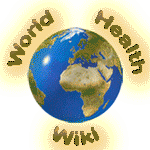Welcome to World Health Wiki
|

The World Health Wiki started in 2007 by students and faculty at Virginia Commonwealth University School of Medicine with the intention of increasing cultural competency and awareness by providing a forum for discussion on various topics.
Aim
|
World Health Wiki is an innovative approach to teaching cultural awareness in the medical school setting. By opening a democratic forum for student discussion of cultural awareness issues it will defuse some of the student criticism and resistance to the introduction of the cultural awareness curriculum content into the core traditional medical school curriculum of normal and abnormal physiology. In addition students can contribute and create larger content areas of the website during elective time if desired.
Rationale
|
| There is an initiative in medical school education to integrate cultural competence into curricula. The AAMC, Association of American Medical Colleges, developed the Tool for Assessing Cultural Competence Training (TACCT) to assist with curriculum content development. This project would address the following TACCT objectives:
At the end of medical school, students will:
- Discuss race, ethnicity, and culture in the context of the medical interview and health care
- Describe their cultural background and biases
- Value the importance of diversity in health care and address the challenges and opportunities it poses.
- Recognize patients’ and families’ healing traditions and beliefs, including ethno-medical beliefs.
- Describe common challenges in cross-cultural communication.
- Engage in reflection about their own cultural beliefs and practices.

|
|
How to use the site
|
|
Most of the pages are discussions composed by third-year medical students during their Family Medicine Clerkship. You can read the discussions based on questions related to the cases below and you can respond with your own thoughts on the Discussion page.
Access the articles by following the links to Case studies or by individual cases below.
- Miguel - a case dealing with language barriers
- Tammy - a case dealing with sexually transmitted diseases
- Charlotte - a case dealing with domestic violence
- Alexander - a case dealing with smoking cessation
Feel free to join the discussions and create your own pages on topics related to cultural competency!
|
Recommended Resources
|
| Check out the following pages for more information on Cultural Competency:
|
Did you know...
|

- Racial and ethnic minorities comprise 26% of the total population of the United States, yet only roughly 6% of practicing physicians are Latino, African American and Native American.
- Under-represented minority (URM) faculty account for only about 4% of U.S. medical school faculty members, and approximately 20% of URM faculty is located at six schools-Howard University, Meharry Medical College, Morehouse School of Medicine, and the three Puerto Rican medical schools.
- Black physicians were found to practice in areas where the proportion of Black residents was nearly five times as high as where other physicians practice. Likewise, Hispanic physicians worked in communities with twice the proportion of Hispanic residents when compared to their non-Hispanic colleagues.
Excerpt from AMSA
|
|

